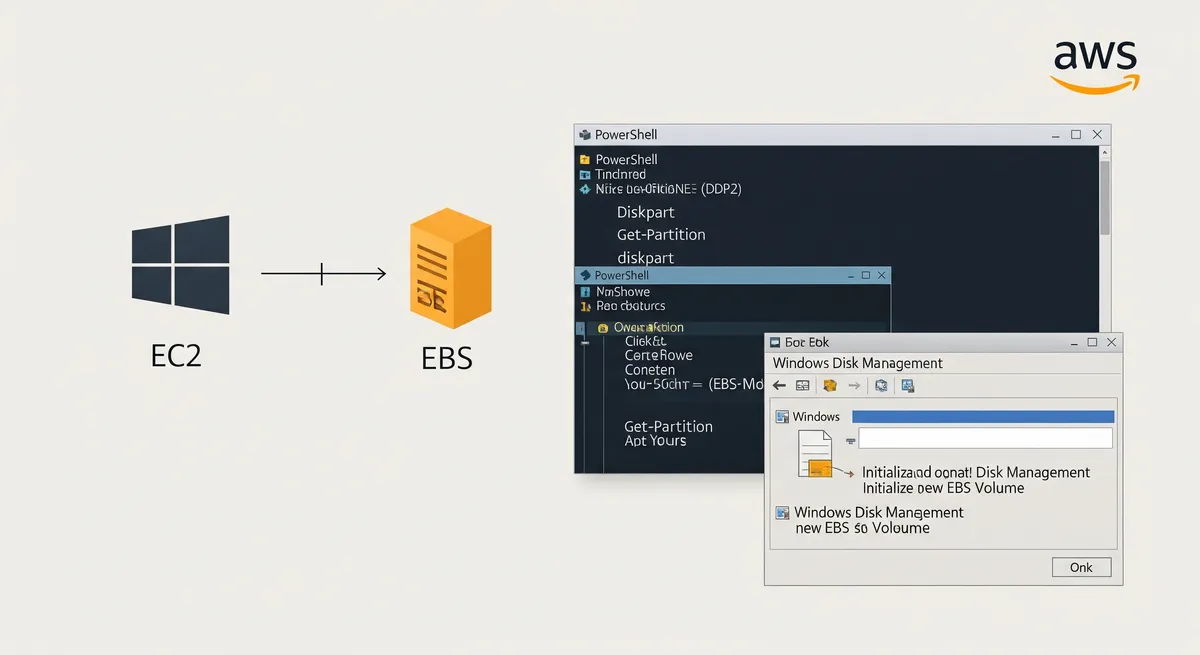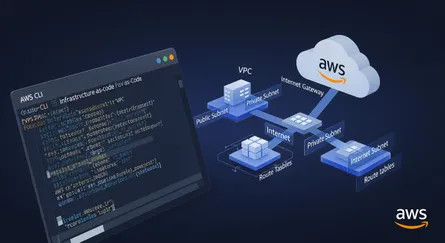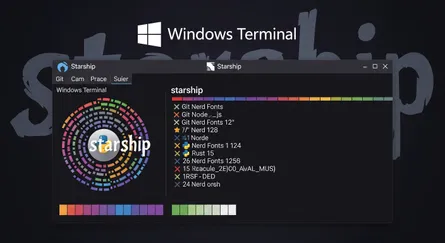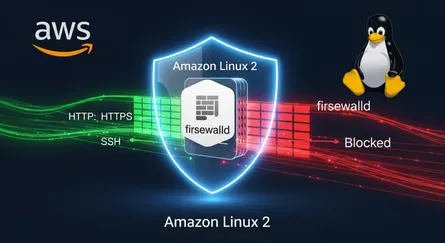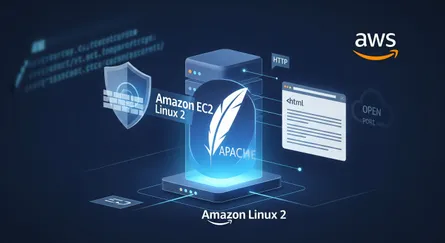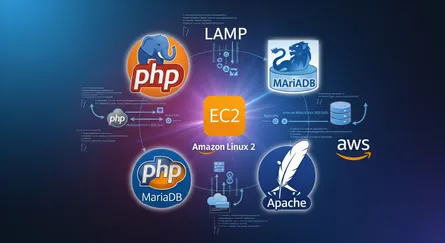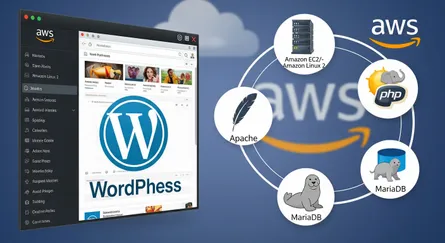Introduction
In this post, we will learn how to connect a EBS volume to an Windows EC2 instance using Powershell/GUI and also how to mount the EBS volume to the EC2 instance.
Prerequisites
- AWS CLI installed and configured
- IAM user with the following permissions:
- AmazonVPCFullAccess
- AmazonEC2FullAccess
- AmazonElasticBlockStoreFullAccess
Create an VPC
Step 1: Create VPC
To create a VPC, run the following command:
# Create a VPCAWS_VPC=$(aws ec2 create-vpc \ --cidr-block 10.0.0.0/16 \ --query 'Vpc.VpcId' \ --output text)
# Add a name tag to the VPCaws ec2 create-tags \ --resources $AWS_VPC \ --tags Key=Name,Value=aws-vpcExplanation:
aws ec2 create-vpc- Create a VPC--cidr-block- The IPv4 network range for the VPC, in CIDR notation.--query- The JMESPath query that is applied to the output.--output- The output format of the command.--resources- The IDs of the resources.--tags- The tags to apply to the resource.
Step 2: Modify your custom VPC and enable DNS hostname support, and DNS support
To modify your custom VPC and enable DNS hostname support, and DNS support, run the following command:
# Enable DNS hostnamesaws ec2 modify-vpc-attribute \ --vpc-id $AWS_VPC \ --enable-dns-hostnames "{\"Value\":true}"
# Enable DNS supportaws ec2 modify-vpc-attribute \ --vpc-id $AWS_VPC \ --enable-dns-support "{\"Value\":true}"Explanation:
aws ec2 modify-vpc-attribute- Modifies the specified attribute of the specified VPC.--vpc-id- The ID of the VPC.--enable-dns-hostnames- Indicates whether the instances launched in the VPC get DNS hostnames.--enable-dns-support- Indicates whether DNS resolution is supported for the VPC.
Step 3: Create a Public Subnet
To create a public subnet, run the following command:
# Create a public subnetAWS_PUBLIC_SUBNET=$(aws ec2 create-subnet \ --vpc-id $AWS_VPC \ --cidr-block 10.0.1.0/24 \ --query 'Subnet.SubnetId' \ --output text)
# Add a name tag to the public subnetaws ec2 create-tags \ --resources $AWS_PUBLIC_SUBNET \ --tags Key=Name,Value=aws-public-subnetExplanation:
aws ec2 create-subnet- Creates a subnet in an existing VPC.--vpc-id- The ID of the VPC.--cidr-block- The IPv4 network range for the subnet, in CIDR notation.--query- The JMESPath query that is applied to the output.--output- The output format of the command.--resources- The IDs of the resources.--tags- The tags to apply to the resource.
Step 4: Enable Auto-assign Public IP on the subnet
To enable auto-assign public IP on the subnet, run the following command:
# Enable auto-assign public IP on the subnetaws ec2 modify-subnet-attribute \ --subnet-id $AWS_PUBLIC_SUBNET \ --map-public-ip-on-launchExplanation:
aws ec2 modify-subnet-attribute- Modifies a subnet attribute.--subnet-id- The ID of the subnet.--map-public-ip-on-launch- Specify true to indicate that network interfaces created in the specified subnet should be assigned a public IPv4 address.
Step 5: Create an Internet Gateway
To create an Internet Gateway, run the following command:
# Create an Internet GatewayAWS_INTERNET_GATEWAY=$(aws ec2 create-internet-gateway \ --query 'InternetGateway.InternetGatewayId' \ --output text)
# Add a name tag to the Internet Gatewayaws ec2 create-tags \ --resources $AWS_INTERNET_GATEWAY \ --tags Key=Name,Value=aws-internet-gatewayExplanation:
aws ec2 create-internet-gateway- Creates an Internet gateway for use with a VPC.--query- The JMESPath query that is applied to the output.--output- The output format of the command.--resources- The IDs of the resources.--tags- The tags to apply to the resource.
Step 6: Attach the Internet Gateway to the VPC
To attach the Internet Gateway to the VPC, run the following command:
# Attach the Internet Gateway to the VPCaws ec2 attach-internet-gateway \ --internet-gateway-id $AWS_INTERNET_GATEWAY \ --vpc-id $AWS_VPCExplanation:
aws ec2 attach-internet-gateway- Attaches an Internet gateway to a VPC, enabling connectivity between the Internet and the VPC.--internet-gateway-id- The ID of the Internet gateway.--vpc-id- The ID of the VPC.
Step 7: Create a Route Table
To create a route table, run the following command:
# Create a route tableAWS_ROUTE_TABLE=$(aws ec2 create-route-table \ --vpc-id $AWS_VPC \ --query 'RouteTable.RouteTableId' \ --output text)
# Add a name tag to the route tableaws ec2 create-tags \ --resources $AWS_ROUTE_TABLE \ --tags Key=Name,Value=aws-route-tableExplanation:
aws ec2 create-route-table- Creates a route table for the specified VPC.--vpc-id- The ID of the VPC.--query- The JMESPath query that is applied to the output.--output- The output format of the command.--resources- The IDs of the resources.--tags- The tags to apply to the resource.
Step 8: Create a custom route table association
To create a custom route table association, run the following command:
# Create a custom route table associationaws ec2 associate-route-table \ --subnet-id $AWS_PUBLIC_SUBNET \ --route-table-id $AWS_ROUTE_TABLEExplanation:
aws ec2 associate-route-table- Associates a subnet with a route table.--subnet-id- The ID of the subnet.--route-table-id- The ID of the route table.
Step 9: Associate the subnet with route table, making it a public subnet
To associate the subnet with route table, making it a public subnet, run the following command:
# Associate the subnet with route table, making it a public subnetaws ec2 create-route \ --route-table-id $AWS_ROUTE_TABLE \ --destination-cidr-block 0.0.0.0/0 \ --gateway-id $AWS_INTERNET_GATEWAYExplanation:
aws ec2 create-route- Creates a route in a route table within a VPC.--route-table-id- The ID of the route table for the route.--destination-cidr-block- The IPv4 CIDR address block used for the destination match.--gateway-id- The ID of an Internet gateway or virtual private gateway attached to your VPC.
Step 10: Create a Security Group
To create a security group, run the following command:
# Create a security groupAWS_SECURITY_GROUP=$(aws ec2 create-security-group \ --group-name aws-security-group \ --description "AWS Security Group" \ --vpc-id $AWS_VPC \ --query 'GroupId' \ --output text)
# Add a name tag to the security groupaws ec2 create-tags \ --resources $AWS_SECURITY_GROUP \ --tags Key=Name,Value=aws-security-groupExplanation:
aws ec2 create-security-group- Creates a security group.--group-name- The name of the security group.--description- A description for the security group.--vpc-id- The ID of the VPC.--query- The JMESPath query that is applied to the output.--output- The output format of the command.--resources- The IDs of the resources.--tags- The tags to apply to the resource.
Step 11: Add a rule to the security group
To add a rule to the security group, run the following command:
# Add a rule to the security group
# Allow RDP >> remote desktop protocolaws ec2 authorize-security-group-ingress \ --group-id $AWS_SECURITY_GROUP \ --protocol tcp \ --port 3389 \ --cidr 0.0.0.0/0 \ --output text
# Add HTTP ruleaws ec2 authorize-security-group-ingress \ --group-id $AWS_SECURITY_GROUP \ --protocol tcp \ --port 80 \ --cidr 0.0.0.0/0 \ --output text
# Add HTTPS ruleaws ec2 authorize-security-group-ingress \ --group-id $AWS_SECURITY_GROUP \ --protocol tcp \ --port 443 \ --cidr 0.0.0.0/0 \ --output textExplanation:
aws ec2 authorize-security-group-ingress- Adds one or more ingress rules to a security group.--group-id- The ID of the security group.--protocol- The IP protocol name or number.--port- The port number.--cidr- The IPv4 CIDR range.--output- The output format of the command.
Create a Windows Server 2022 EC2 Instance
Step 1: Get the latest AMI ID
To get the latest AMI ID, run the following command:
# Get the latest AMI IDAWS_AMI=$(aws ec2 describe-images \ --owners 'amazon' \ --filters 'Name=name,Values=amzn2-ami-hvm-2.0.*' \ 'Name=state,Values=available' \ --query 'sort_by(Images, &CreationDate)[-1].[ImageId]' \ --output 'text')Explanation:
aws ec2 describe-images- Describes one or more of the images (AMIs, AKIs, and ARIs) available to you. Images available to you include public images, private images that you own, and private images owned by other AWS accounts but for which you have explicit launch permissions.--owners- Filters the images by the owner. Specify an AWS account ID,self(owner is the sender of the request), or an AWS owner alias (valid values areamazon,aws-marketplace,microsoft).--filters- One or more filters. Use a filter to return a more specific list of results.--query- The JMESPath query that is applied to the output.--output- The output format of the command.
Step 2: Create a Key Pair
To create a key pair, run the following command:
# Create a key pairaws ec2 create-key-pair \ --key-name aws-key-pair \ --query 'KeyMaterial' \ --output text > aws-key-pair.pem
# Change the permissions of the key pairchmod 400 aws-key-pair.pemExplanation:
aws ec2 create-key-pair- Creates a 2048-bit RSA key pair with the specified name. Amazon EC2 stores the public key and displays the private key for you to save to a file. The private key is returned as an unencrypted PEM encoded PKCS#8 private key. If a key with the specified name already exists, Amazon EC2 returns an error.--key-name- The name for your key pair.--query- The JMESPath query that is applied to the output.--output- The output format of the command.
Note
The private key, which is returned as an unencrypted PEM encoded PKCS#8 private key, is only returned if you have access to the key pair. You must provide the corresponding key pair file when you launch an instance.
Note
The key pair you will decrypted using AWS EC2 console, to get the password.
Step 3: Create an EC2 Instance
To create an EC2 instance, run the following command:
# Create an EC2 instanceAWS_INSTANCE=$(aws ec2 run-instances \ --image-id $AWS_AMI \ --instance-type t2.micro \ --key-name aws-key-pair \ --monitoring "Enabled=false" \ --security-group-ids $AWS_SECURITY_GROUP \ --subnet-id $AWS_PUBLIC_SUBNET \ --query 'Instances[0].InstanceId' \ --output text)
# Add a name tag to the EC2 instanceaws ec2 create-tags \ --resources $AWS_INSTANCE \ --tags Key=Name,Value=aws-instance-windowsExplanation:
aws ec2 run-instances- Launches the specified number of instances using an AMI for which you have permissions.--image-id- The ID of the AMI.--instance-type- The instance type.--key-name- The name of the key pair.--monitoring- Enables detailed monitoring (disabled by default).--security-group-ids- The IDs of the security groups.--subnet-id- The ID of the subnet in which to launch the instance.--query- The JMESPath query that is applied to the output.--output- The output format of the command.
Step 4: Wait for the EC2 Instance to be running
To wait for the EC2 instance to be running, run the following command:
# Wait for the EC2 instance to be runningaws ec2 wait instance-running \ --instance-ids $AWS_INSTANCEExplanation:
aws ec2 wait instance-running- Wait until an instance is running.--instance-ids- The IDs of the instances.
Step 5: Get the public IP address of the EC2 Instance
To get the public IP address of the EC2 instance, run the following command:
# Get the public IP address of the EC2 instanceAWS_PUBLIC_IP=$(aws ec2 describe-instances \ --instance-ids $AWS_INSTANCE \ --query 'Reservations[0].Instances[0].PublicIpAddress' \ --output text)Explanation:
aws ec2 describe-instances- Describes one or more of your instances.--instance-ids- The IDs of the instances.--query- The JMESPath query that is applied to the output.--output- The output format of the command.
Create an EBS Volume
Step 1: Create an EBS Volume
To create an EBS volume, run the following command:
# Get the availability zone for the EC2 instanceAWS_AVAILABILITY_ZONE=$(aws ec2 describe-instances \ --instance-ids $AWS_INSTANCE \ --query 'Reservations[0].Instances[0].Placement.AvailabilityZone' \ --output text)
# Create an EBS volumeAWS_VOLUME=$(aws ec2 create-volume \ --availability-zone $AWS_AVAILABILITY_ZONE \ --size 10 \ --volume-type gp2 \ --query 'VolumeId' \ --output text)
# Add a name tag to the EBS volumeaws ec2 create-tags \ --resources $AWS_VOLUME \ --tags Key=Name,Value=aws-volumeExplanation:
aws ec2 describe-instances- Describes one or more of your instances.--instance-ids- The IDs of the instances.--query- The JMESPath query that is applied to the output.--output- The output format of the command.aws ec2 create-volume- Creates an EBS volume that can be attached to an instance in the same Availability Zone.--availability-zone- The Availability Zone in which to create the volume.--size- The size of the volume, in GiBs.--volume-type- The volume type.--query- The JMESPath query that is applied to the output.--output- The output format of the command.
Note
Availability zone for the EC2 instance and EBS volume must be the same.
Otherwise, you will get the following error: InvalidParameterValue: The requested Availability Zone is currently constrained and only m3.medium or m3.large instances can be launched.
Step 2: Wait for the EBS Volume to be available
To wait for the EBS volume to be available, run the following command:
# Wait for the EBS volume to be availableaws ec2 wait volume-available \ --volume-ids $AWS_VOLUMEExplanation:
aws ec2 wait volume-available- Wait until a volume is in the available state.--volume-ids- The IDs of the volumes.
Attach the EBS Volume to the EC2 Instance
Step 1: Attach the EBS Volume to the Windows Server EC2 Instance
To attach the EBS volume to the Windows Server EC2 instance, run the following command:
# Attach the EBS volume to the Windows Server EC2 instanceaws ec2 attach-volume \ --device xvdf \ --instance-id $AWS_INSTANCE \ --volume-id $AWS_VOLUMEExplanation:
aws ec2 attach-volume- Attaches an EBS volume to a running or stopped instance and exposes it to the instance with the specified device name.--device- The device name (for example, /dev/sdh or xvdh).--instance-id- The ID of the instance.--volume-id- The ID of the EBS volume.
Step 2: Wait for the EBS Volume to be in-use
To wait for the EBS volume to be in-use, run the following command:
# Wait for the EBS volume to be in-useaws ec2 wait volume-in-use \ --volume-ids $AWS_VOLUMEExplanation:
aws ec2 wait volume-in-use- Wait until a volume is in the in-use state.--volume-ids- The IDs of the volumes.
Connect to the Windows Server EC2 Instance
Step 1: Connect to the Windows Server EC2 Instance using RDP (Remote Desktop Protocol) in Linux
If you are using Linux, you can connect to the Windows Server EC2 instance using RDP (Remote Desktop Protocol) in Linux. To do so, you need to install the remmina package. To install the remmina package, run the following command:
# Install the remmina package
# Arch Linuxsudo pacman -S remmina
# Debian/Ubuntusudo apt install remmina -y
# CentOS/RHELsudo yum install remmina -y
# Fedorasudo dnf install remmina -y
# OpenSUSEsudo zypper install remmina -yExplanation:
pacman- Arch Linux package manager.apt- Debian/Ubuntu package manager.yum- CentOS/RHEL package manager.dnf- Fedora package manager.zypper- OpenSUSE package manager.
Step 1.1: Create a new RDP connection
- Click on the
+button to add a new connection. - Enter the following details:
Name- Enter a name for the connection.Protocol- SelectRDP.Server- Enter the public IP address of the Windows Server EC2 instance.Username- Enter the username of the Windows Server EC2 instance.Password- Enter the password of the Windows Server EC2 instance.
- Click on the
Savebutton.
Note
To get the password of the Windows Server EC2 instance, run the following command:
# Get the password of the Windows Server EC2 instanceEC2_INSTANCE_PASSWORD=$(aws ec2 get-password-data \ --instance-id $AWS_INSTANCE \ --priv-launch-key aws-key-pair.pem \ --query 'PasswordData' \ --output text)
# Desplay the password of the Windows Server EC2 instanceecho $EC2_INSTANCE_PASSWORDExplanation:
aws ec2 get-password-data- Retrieves the encrypted administrator password for the instances running Windows.--instance-id- The ID of the instance.--priv-launch-key- The private key that is required to decrypt the password data.--query- The JMESPath query that is applied to the output.--output- The output format of the command.

Step 1.2: Connect to the Windows Server EC2 Instance
- Click on the
Connectbutton to connect to the Windows Server EC2 instance.

Step 2: Connect to the Windows Server EC2 Instance using RDP (Remote Desktop Protocol) in Windows
If you are using Windows, you can connect to the Windows Server EC2 instance using RDP (Remote Desktop Protocol) in Windows. To do so, you need to install the Microsoft Remote Desktop app. To install the Microsoft Remote Desktop app, run the following command:
# Install the Microsoft Remote Desktop appwinget install Microsoft.RemoteDesktopExplanation:
winget- Windows package manager.
Step 2.1: Create a new RDP connection
- Click on the
+button to add a new connection. - Enter the following details:
Name- Enter a name for the connection.Computer- Enter the public IP address of the Windows Server EC2 instance.Username- Enter the username of the Windows Server EC2 instance.Password- Enter the password of the Windows Server EC2 instance.
Note
To get the password of the Windows Server EC2 instance, run the following command:
# Get the password of the Windows Server EC2 instanceEC2_INSTANCE_PASSWORD=$(aws ec2 get-password-data \ --instance-id $AWS_INSTANCE \ --priv-launch-key aws-key-pair.pem \ --query 'PasswordData' \ --output text)
# Desplay the password of the Windows Server EC2 instanceecho $EC2_INSTANCE_PASSWORDExplanation:
aws ec2 get-password-data- Retrieves the encrypted administrator password for the instances running Windows.--instance-id- The ID of the instance.--priv-launch-key- The private key that is required to decrypt the password data.--query- The JMESPath query that is applied to the output.--output- The output format of the command.
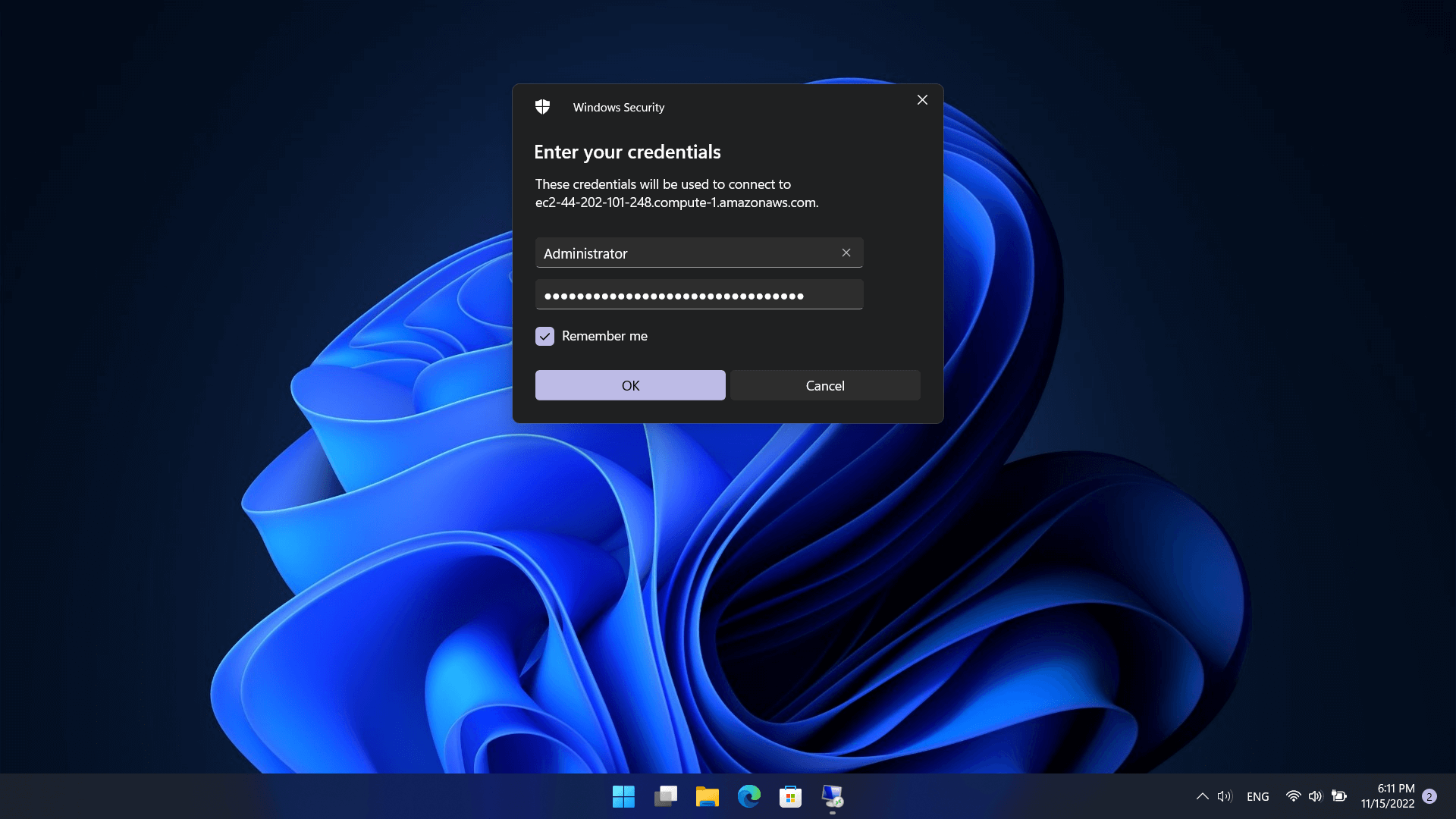
Step 2.2: Connect to the Windows Server EC2 Instance
- Click on the
Connectbutton to connect to the Windows Server EC2 instance.
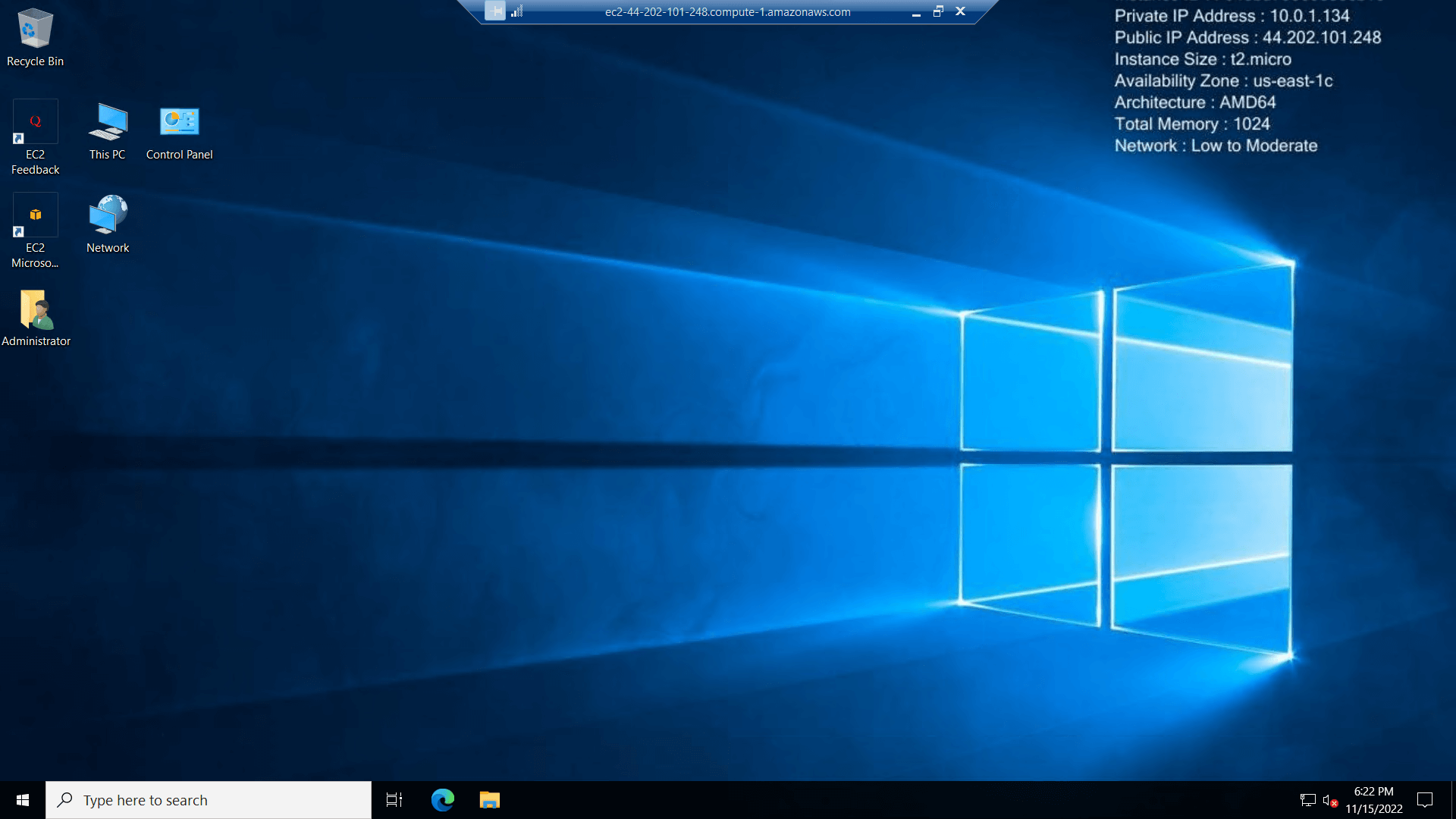
Connect to the EBS Volume
Connect to the EBS Volume using PowerShell
Step 1: Connect to the EBS Volume using PowerShell
- Open the
PowerShellapp. - Run the following command to connect to the EBS volume:
# Connect to diskpartdiskpart
# List the diskslist disk
# Select the diskselect disk 1
# initialize the diskconvert gpt
# Create a new partitioncreate partition primary
# List the partitionslist partition
# Select the partitionselect partition 2
# Assign a drive letterassign letter=D
# Format the partitionformat fs=ntfs quick
# Exit diskpartexitExplanation:
diskpart- DiskPart is a command-line tool that you can use to manage disks and volumes.list disk- Lists all disks on the computer.select disk- Selects a disk for use.convert gpt- Converts a disk to the GPT partition style.create partition primary- Creates a primary partition on the selected disk.list partition- Lists all partitions on the selected disk.select partition- Selects a partition for use.assign letter- Assigns a drive letter to the selected partition.format fs=ntfs quick- Formats the selected partition.exit- Exits DiskPart.

Step 2: Check the EBS Volume
- Run the following command to check the EBS volume:
# List the disksGet-Partition | Get-VolumeExplanation:
Get-Partition- Gets the partitions on a disk.Get-Volume- Gets the volumes on a disk.
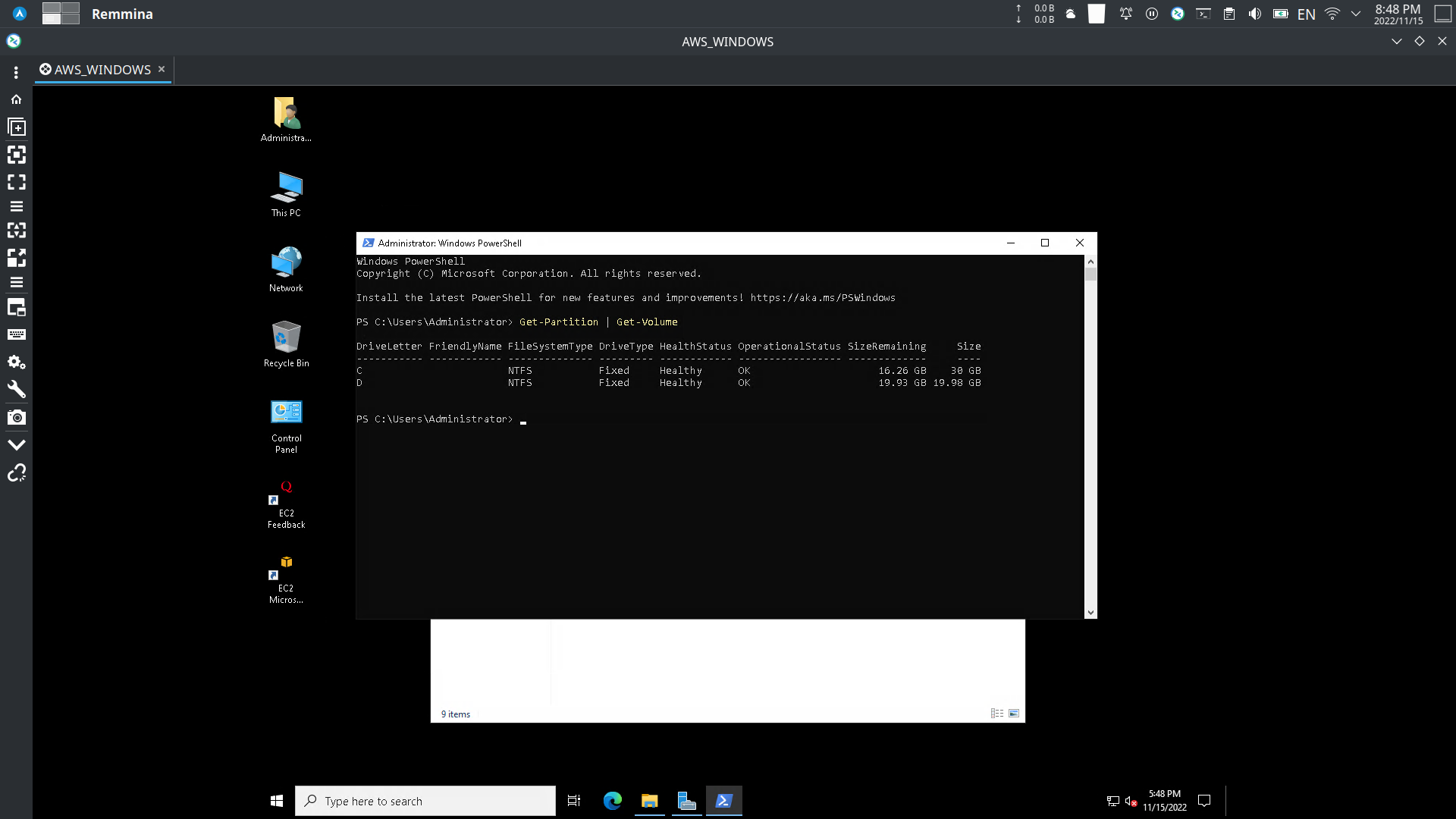
Connect to the EBS Volume using Disk Management
Step 1: Connect to the EBS Volume using Disk Management
- Open the Sersh bar by pressing the
Windowskey +S. - Type
diskmgmt.mscand pressEnter. - Right-click on the
Disk 1and click on theOnlineoption. - Right-click on the
Disk 1and click on theInitialize Diskoption. - Right-click on the
Unallocatedspace and click on theNew Simple Volumeoption. - Click on the
Nextbutton. - Click on the
Nextbutton. - Click on the
Nextbutton. - Click on the
Finishbutton.

Step 2: Check the EBS Volume using Disk Management
- Right-click on the
Disk 1and click on thePropertiesoption. - Click on the
Volumestab. - Click on the
D:drive.

Conclusion
In this tutorial, we learned how to connect a EBS volume to an Windows EC2 instance using PowerShell GUI.
References
- Amazon EC2 User Guide for Windows Instances
- Amazon EBS volumes
- Attach an Amazon EBS volume to an instance
- Make an Amazon EBS volume available for use on Windows
- AWS Command Line Interface (CLI) User Guide
- AWS CLI Command Reference - ec2
- Amazon VPC User Guide
- AWS Identity and Access Management (IAM) User Guide
- Connect to your Windows instance using RDP
- DiskPart command-line options (Microsoft Docs)
- Initialize new disks (Microsoft Docs)
- PowerShell Get-Disk cmdlet
- PowerShell Initialize-Disk cmdlet
- PowerShell New-Partition cmdlet
- PowerShell Format-Volume cmdlet
